Earlier in the month, the Indianapolis Star featured an article on the extensive development plans that are materializing for the City of Greenwood, with the goal of turning the historic main street back into a desirable retail destination for locals and visitors.  The southerly suburb’s commercial center sits at the convergence of Main Street and Madison Avenue, stretching approximately one block in each direction, though the bulk of the historic architecture rests along Main Street, the east-west axis. By some locals’ perceptions, Greenwood’s Main Street has trended downward in the last decade, losing longtime tenants such as the Bay Window restaurant. A few of the buildings are looking a little dowdy, but “blighted†in my opinion would be an unfair label; it’s not hard to find far more dilapidated main streets elsewhere in the country (and in Indiana). Nonetheless, Greenwood’s small downtown is hardly lively, and while the idea of replicating Carmel’s colossal investments is unlikely to appeal to many of the suburb’s citizens, most people who have participated in these meetings have shown genuine enthusiasm toward the notion of revitalizing the area.
Much of the future of Greenwood’s Main Street hinges upon the development decisions that will take place at the southwest corner of the intersection. Here’s what it looks like, as viewed from the northeast corner, looking across:
Many years ago, city leadership decided to demolish all the old commercial buildings at this intersection to make way for public parking. The photo below compares the demolished southwest corner of the intersection with the intact northwest.
The vantage point from that photo comes from the southwest parking lot (where the building used to be) looking across the street. Through the stroke of a pen, the City of Greenwood lost close to one quarter of the historic buildings from its main street.
Hindsight is 20/20, and most stakeholders recognize today that such a defiant anti-preservationist gesture was a mistake. Now the goal is to find a suitable infill development that will match the general urban form of Main Street while providing opportunities for retail, offices, housing and a parking garage. The rendering from the Star article reveals much of this plan, to be funded by a new Tax Increment Financing district. By most metrics, it seems like a smart move: a large mixed-use building that will add much-needed density to an area that will depend on visibility to keep its retail core active and energized. Here’s what an early rendering looks like:
This building hopes to catalyze the reorienting of Greenwood’s Main Street into a retail and commercial destination that can compete with the goliath Greenwood Park Mall a mile to the north. A full presentation providing greater detail and imagery to support the plan is available on the City of Greenwood’s Economic Development Commission webpage.
From our discussion with a representative from the Economic Development Commission, Greenwood has more momentum and community support for a comprehensive downtown revitalization plan than it ever has in the past.  However, Main Street Greenwood also faces other engineering challenges that may prove much more difficult to accommodate than simply replacing big parking lot with a mixed-use building. By almost any standard, the road is narrow, and so are the sidewalks. It needs to accommodate a fairly high volume of traffic, yet it remains predominantly two lanes, with occasional expansions for a left-turn lane, such as at Main Street’s intersection with Madison Avenue—the heart of Greenwood’s downtown. Here’s a view of Main Street facing westward, right before it intersects Madison Avenue:
Here’s looking at that same intersection facing eastward:
It is a two-lane street with a turn lane. The white stripes on the right side of the road that suggest on-street parking spaces are deceptive, because the sign on the sidewalk shows that it is either prohibited or restricted for 15-minute unloading intervals at select times. Here’s a slightly clearer image of the restrictive signs:
Notice the traffic blocking the on-street parking spaces. If those spaces were permanently set aside, it would induce serious congestion in the street segment where vehicles are preparing to make left turns but the turn lane does not yet exist. It would also seriously restrict the lane used for making right turns. At this point, the on-street parking is understandably only available for select occasions, but it certainly impedes the accessibility of the storefronts along Main Street to some convenient short-term parking spaces.
The adjacent sidewalk is problematic as well:
It’s narrow enough that it would be hard to accommodate further amenities like bike racks, planters, or permanent street furniture. The sidewalks along Madison Avenue downtown are even worse:
Two people can barely walk side-by-side. The sidewalks themselves might meet the acceptable minimum width for a small town’s commercial district, but, after several decades of annexation and expansion, Greenwood’s population approached 50,000 at the 2010 Census.  It’s more than a small town; it’s a significant suburb.  A city of this size understandably aspires to something more than a single intersection if it hopes for its downtown to evolve into a regional destination, but these four-foot wide sidewalks (complete with intermittent utility poles to exacerbate the clutter) simply are not suitable capacity to serve a “destination downtown†to a medium sized city.
In short, it behooves Greenwood to re-evaluate the scale of its fundamental urban infrastructure.  Otherwise, it will be hard for the city to restore the appeal it might have had when it was the commercial center of a humble little farming community. Thanks to the initiatives of the Greenwood Economic Development Commission, the proposal includes a complete rethinking of vehicular traffic circulation in the area, so that it might achieve a better harmony between cars and pedestrians, while integrating urban infill on that underutilized southwest corner. This component of the revitalization plan also shows a high level of dedication, but, from the perspective of the two Urban Indy writers who have engaged in the project, it merits further consideration. As indicated from the plan, here is an aerial photograph of downtown Greenwood, at the intersection of Main Street and Madison Avenue. Meridian Street is the other north-south collector road that runs near the right (east) of the frame. (Note to those unfamiliar with Greenwood: this Meridian Street does NOT connect with the Meridian Street arterial in Indianapolis.)
Here’s a conventional Google Maps representation, which shows the street names.
All streets are currently two-way, as indicated by the aerial. However, this Downtown Revitalization Plan plans to alter traffic patterns dramatically, using the configuration below:
Under this new plan, West Main Street would run one-way westward through downtown. Vehicles seeking to travel east on Main Street would be forced to turn onto Market Plaza, the road shaped like a backwards J. The intersection of Market Plaza and Main Street will look like the rendering below, featuring the new construction on the southwest parking lot.
From there, Market Plaza will bend around to the south and then to the east. It will intersect Madison Avenue in a roundabout, where vehicles can travel northward on Madison Avenue until they reach the small bow-shaped street, Machledt Drive, which will run through Old City Park and will be expanded to accommodate one-way eastbound traffic. Macheldt Drive will meet two-way Meridian Street, at which point motorists can head north to continue eastward on a Main Street that is once again two-way.  The biggest goal from this reconfiguration will be to reduce the need for turn lanes on Main Street, allowing the street to shrink to two lanes in its entirety, so that part of the margins of the road can be narrowed to allow for wider sidewalks. Most Economic Development Commission meetings have suggested that local businesses support the plan.
It’s a complicated idea that demonstrates some careful rethinking, but is it the best option? I’m by no means certain it is a bad solution to a challenging design predicament that allows little room for flexibility, but it does raise a few questions that might otherwise get ignored. Here are the most critical considerations that come to mind for those of us at Urban Indy involved in the project:
1)   Are one-way streets optimal for retail? While one-way makes it easier for cars to get from A to B with fewer impediments, it also means that motorists have only one direction by which to approach and view the streetscape. Thus, retail that fronts a one-way street has 50% of the visibility of a two-way street. The most successful commercial strips in downtown Indianapolis are Meridian Street through the Wholesale District and Massachusetts Avenue. Imagine if these streets, or Broad Ripple Avenue (another narrow collector street) were one way: how could that possibly benefit the businesses when people headed in another direction will have to use another street to get around? Bear in mind that Indy has reduced some of its one-way streets in recent years, with a portions of Delaware Street and College Avenue reverting to two-way traffic for the first time in decades. Meanwhile, I wrote about Kokomo on my own blog, where city leaders recently eliminated all one-way streets downtown. Judging from these decisions, other communities have often decided that one-way streets no silver bullet for revitalizing downtowns.
2)   Could a confusing traffic pattern repel the target audience?  When I first saw the green-and-white street map with the directional arrows from the Downtown Revitalization Plan, it made me think of a New England town center. Those who have lived in that region probably know what I’m talking about. Many towns in Massachusetts or Rhode Island, though no bigger than Greenwood, have a town center that uses a tangle of non-parallel one ways, roundabouts, and block-long stub streets that might require backtracking to get the motorists back in the direction they want to go. These baffling town centers work fairly well in New England because no alternatives exist; the streets were never organized in a conventional grid pattern, so modern traffic engineers forced them to adapt to a post-vehicular setting. Conversely, most Indiana town centers are intensely grid based, so motorists have no need to orient themselves to an idiosyncratic new traffic pattern. I fear that this new layout could hurt downtown Greenwood’s brand if people lose patience with it, thereby achieving the opposite of the desired effect.
3)   Why should a downtown revitalization plan put traffic flow at such high priority? This question may be the single most critical. Attractive downtowns, big and small, do not usually have cars zipping through them at high speeds. Why does Main Street Greenwood need to function at the LOS (Level of Service) of a major thoroughfare, when improved pedestrianism is also a clearly articulated goal? If vehicles can travel too quickly, it won’t matter how much wider those sidewalks are—people still won’t feel safe or comfortable. The zoomed-out Google Map below might shed some light on a kinder, gentler approach:
Decades ago, INDOT built the exit ramp at Main Street allowing Interstate 65 to to Greenwood. This exit ramp opened Main Street (also known as County Road 950 North) to a significantly higher traffic volume than it and the small downtown had previously accommodated. While the DOT widened Main Street at the I-65 interchange, it tapers quickly and remains a modest two-lane as it continues westward through Greenwood’s historic center. Approximately a decade ago, INDOT supported the construction of another exit ramp about a mile north, at County Line Road.  This road—the boundary between Indianapolis and Greenwood—is a busy arterial, with four or five lanes through much of its duration. It can handle much higher traffic volumes. So can Emerson Avenue and Smith Valley Road, which runs parallel to Main Street to the south. The Emerson Avenue portion looks like this:
Another four-lane arterial. While Emerson Avenue attenuates into two-lane at the curve where it becomes Smith Valley Road, this street still has lower population density, fewer intersections, and higher speed limits than Main Street. In short, both County Line Road and Emerson Avenue/Smith Valley Road could serve as bypass streets for those seeking east-west travel at high speeds, while Main Street is the Business District Route, suitable for those visiting the town center and all its amenities.
I am hardly a traffic engineer, and I suspect that I am not accounting for a number of other critical considerations necessary in the reconfiguration of Greenwood’s downtown. But my planning background impels me to ask the above questions, which could help develop a nuanced design that proves the lynchpin to Main Street’s success. The current plan would require significant public works investment, an education of the public to the new traffic flow, and the widening of Machledt Drive into a busier one-way collector road at the likely expense of parkland. My recommendation isn’t exactly a “do nothing†approach, but it certainly involves doing less, with the goal of saving public money that can ideally be put to better use.
I recommend leaving Main Street at two-way through its entire length. Instead of encouraging high-speed traffic flow through an area originally designed for pedestrians, the City should use signage to guide motorists to Emerson Avenue/Smith Valley Road or County Line Road as higher-speed bypass routes. Greenwood could benefit from directional signage, even at the I-65 interchanges, perhaps on par with Plainfield’s excellent wayfinding signs. In the meantime, Main Street Greenwood could benefit from traffic calming devices such as bulb-outs or chicanes, which would allow for wider sidewalks where it matters most. The cartways could be narrower, encouraging slower vehicular speeds and possibly allowing enough room for some permanent on-street parking near the storefronts. If it is necessary to eliminate the left-turn lanes to make more room for streetscape enhancements (and it very well may not be necessary), turning left onto Madison Avenue could be restricted to certain times of day or special conditions, while additional signage could indicate alternative routes on Meridian Street, Brewer Street, or Market Plaza. Instead of spending colossal amounts of money on a roundabout or Machledt Drive widening, this money could go toward improving the pedestrian experience on both Main Street and Madison Avenue.
This solution will inevitably do little to resolve vehicular congestion along Main Street, but since the existing built environment does not allow all modes equal levels of accommodation, I remain convinced that high-speed traffic flow is the least essential element to a revitalized downtown Greenwood. A busy night along Broad Ripple Avenue sees traffic at an absolute gridlock, and no one seems to mind; people familiar with the area know that Broad Ripple Avenue (even without those bike lanes) was never the way to get quickly from A to B. Our hope is that as plans for Greenwood’s Main Street continue to evolve, the Economic Development Commission, traffic engineers, political leaders, small business owners, and other interested citizens continue to consider the full design ramifications to a project that has equal potentiality to fail or to flourish. Sensitivity to these details may not guarantee the latter of those two outcomes, but it will certainly improve the chances. Greenwood by and large has no interest in duplicating Carmel, but it should review the Carmel vision with the hope that it can learn from that suburb’s mistakes. We at Urban Indy look forward to hearing other people’s opinions and perspectives; ideally this article will serve as a sounding board that can help Greenwood devise the best solution for its worthy downtown.

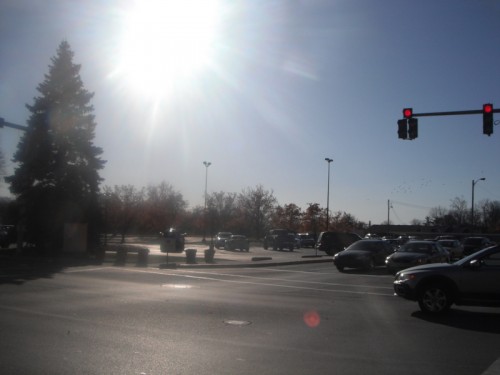
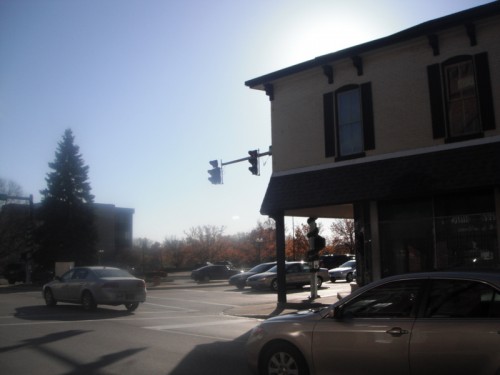
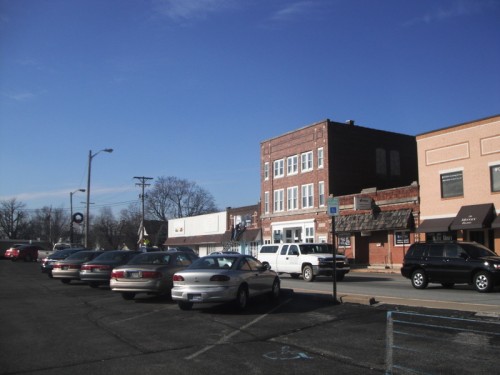



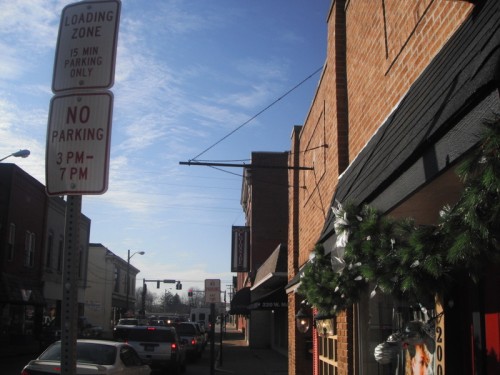
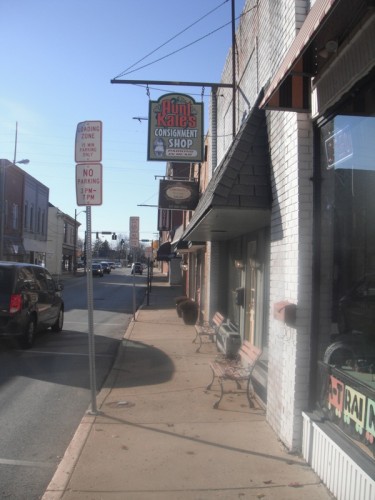

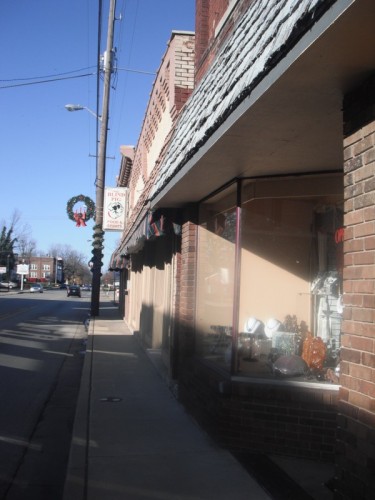
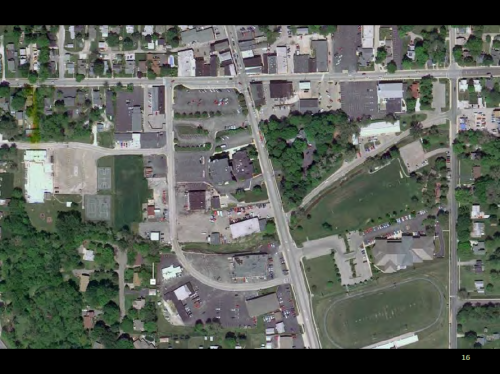
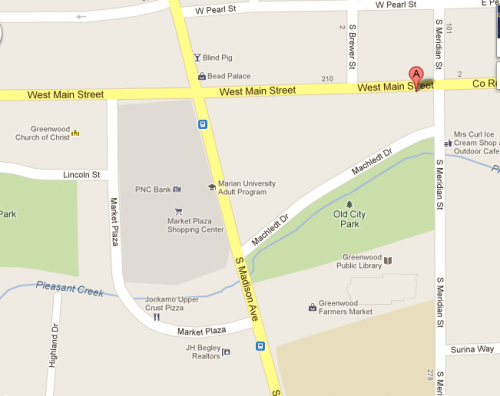
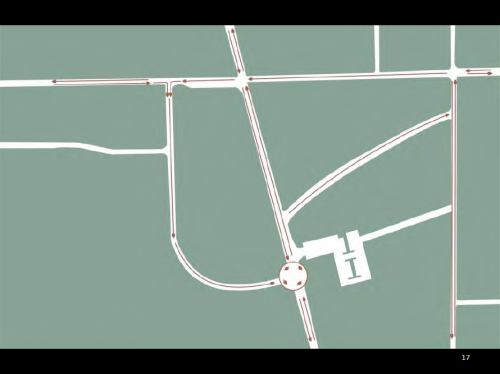
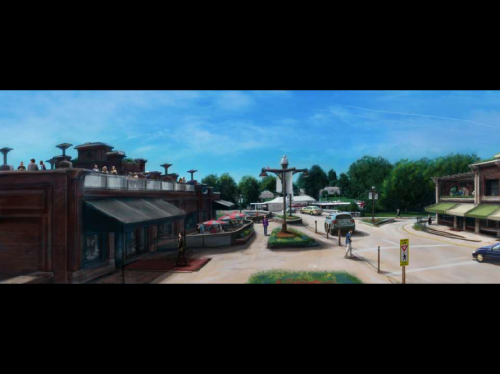

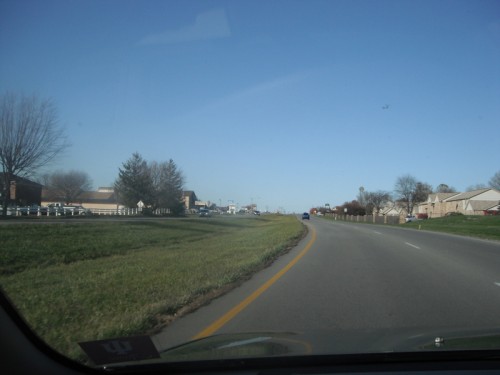
The traffic plan is pretty crazy. It requires 5 turns and more than doubles the distance for eastbound traffic to get around. If Market Plaza directly intersected with Machledt and Machledt directly intersected with Main, then it might not be so bad, but the short hops on Madison and Meridian (requiring left turns no less) make it pretty useless.
Overall I think the best solution when dealing with traffic issues like this is to provide alternates but don’t force them. At most restrict left turns at the Madison/Main intersection, and use the other connecting streets. Otherwise, just make sure there are alternate paths rather than restricting them (or remove restrictions which may prohibit traffic through the adjoining residential areas). This does “something” to address the problem, but requires little investment in new infrastructure and maintenance. A roundabout might still not be a bad idea if it’s used as an entrance element or welcome to the downtown area.
The rendering of that infill building also illustrates some other problems. First and foremost is the huge sweeping turn of the road. That’s a high speed geometry, and the piddly little yield sign is a band-aid that just screams “engineering failure.” Note how the building retreats from the street behind planters and stairs. Even if it didn’t, it seems that no architects are interested in properly addressing street corners. So many infill projects like this, rather than punctuating the corner, seem to leave it as some unresolved mess of open space where disparate geometries of the building crash together
Great point. That high turning radius on that corner needs to go. In fact, in this plan, there would be no point to even having this if there were no east-bound traffic on Main.
1) Instead of giving eastbound and westbound Main a green light at the same time, give each a turn having green light and left-turn green arrow at the same time.
2) Move the 15-minute parking spaces to the new development and use the space to widen the sidewalk on Main east of Madison. Leave the lane configurations on Main the same as they are.
3) Cut a notch in the corner of the new development on the southwest corner, to create a mini-plaza. This can absorb some of the need for planters and benches for the whole intersection, lessening the overall impact of the narrow sidewalks on the other corners. This will reduce the retail space, but not window space.
4) Where alleys exist between retail buildings, brick them and make them pedestrian-only, to encourage the use of parking in the rear of the businesses
5) Encourage the development of another retail node at Main and the railroad track in anticipation of a commuter train stop there, and make Main more pedestrian-friendly along the stretch that connects them.
Thanks for your comments, everyone. The turn radii were something I didn’t touch upon in the article, but our discussions suggested that engineering plans want to make them gentler for vehicles. Not the best solution in my opinion, and it appears most people here would agree.
Flavius, you’ve raised some great points in regards to shifting the “teaser parking” on-street and integrating it into the new development–another feature that occurred to me, but you articulated it far better than I would. As Jeffrey suggests, the smart (and cost-efficient) option is to provide alternatives but not to force them.
I think this is another case of the original plan being designed with a windshield perspective. And if you design for cars, that what you end up with. This place deserves something better.
I’m hoping the final plan for greenwood main street recognizes that people, not cars, should be the focus. My suggestion would be to remove the lane markings, the traffic lights, and the road signs. Let the people and cars negotiate a slow zone so that people feel safe crossing the street (jaywalking!) and cars don’t feel the need to drive fast. This works almost perfectly on Monument Circle, compared to other alternatives I’ve seen.
I agree with Graeme. If you compare this to the success that Carmel has had with placing the pedestrian first with it’s revitalization efforts, the argument is tough to refute. Replacing car-centric design with pedestrian oriented design will win out
Chuck mentioned that he took a group of stake-holders on a drive through the area to get their thoughts…….I asked if he had taken anyone on a walk through the area and the answer was no. How will most people understand a pedestrian sense of place, when they are, as Graeme said “designing with a windshield perspective”? Why is every engineer/communtiy leaders first thought for improving an area to take people on a drive? MISTAKE #1. ONE WAY STREETS KILL DOWNTOWNS!
Um…no. This kind of blanket dogmatic assertion is both irrelevant and provably incorrect. Yelling it (all caps) doesn’t help the discussion.
Ever been to NYC or Philadelphia or Chicago? Manhattan, Center City, and The Loop are almost all one-way streets. They all work because they are ALSO pedestrian-friendly and have some parking at the curb.
.
That said…I agree in this case that the one-way out-of-the-way re-route proposed would probably kill this little corner district. Creating more right of way (for on-street parking and pedestrian ways) while redeveloping the now-empty corner with concealed or structured parking is the way to go.
Chris,
I should have been more selective as to the scale of downtown. The cities you noted are all major metros that could probably do about anything and would still survive. NYC could close streets to cars, make them one way highways, turn them into canals and there would still be businesses and people that would locate there.
Scale is key. I have come around to the point of view that high-speed one way arterials are not particularly supportive of corner nodes, which is really what the Greenwood “district” is. But that has mostly to do with their inhospitable treatment of pedestrians and lack of anchoring functions and/or institutions. (Everything can’t be retail.)
.
Take a Google Maps tour of Main Street, Norman OK. (Walkable small downtown district of a car-dependent “city”/sprawlburg of 100,000, a bit bigger than a combined Greenwood-Center Grove). About the same scale as Mass Ave., one way with angled parking and pedestrian enhancements. Like so many small downtowns where a highway was the main street, it was converted to a one-way pair decades ago, before the interstate stretched the town center west.
.
It’s one of the places grownups in Norman go to avoid the other walkable district at the north edge of the OU campus, and they’ve enhanced the classic county-seat feel and preserved many of the historic structures (which aren’t that old since the city is barely 100). City and county government functions are there, so it’s where a lot of lawyers, real-estate types and bankers work. There are still dentists and doctors and accountants and small-business offices.
.
It comes down to “build it and they will come” isn’t enough. It’s necessary to build on something, to strengthen what’s there by making it pedestrian-frendly even when many people will be arriving by car.
It should be designed for pedestrians, but cars should not be routed around it. Drivers will forgive the intersection for slow traffic. But if they are routed around it completely, they will go on ignoring this corner, and they will not know or care whether it has had a shopping-friendly makeover.
Great insightful comments. There needs to be auto traffic in both directions for it to remain relevant. To answer Joe’s question, the simple answer is: because the engineers and community leaders spend most of their time driving in auto-oriented environments so it seems foreign to them to get out of the car and actually walk around on the sidewalks and cross the streets. If only all the commenters on this post were in charge of making decisions on these projects, we’d be much better off.
I just wanted to mention some points of clarification and observation regarding the above:
1. The mixed-use building shown in the rendering would be located at the corner of Market Plaza and Lincoln Street (the old City Pool would have been located in the background to the right), not on the current path of Main Street and not in the parking lot at the southwest corner of Main and Madison as mentioned (there is currently an old used car lot on the right in the first rendering and the Salvation Army store is located on the left in the other rendering). The renderings depict multi-use buildings, which might possibly not even be zoned in Greenwood at this time from what I understand (which can be fixed by the City Council and/or zoning folks).
2. Along those lines then, the curve seen in the picture is actually the curve from the side street (LIncoln) onto Market Plaza, and is not part of the plan for the Main Street eastbound lane. So there is no dangerous curve as mentioned at that location for the proposed portion of Main/Market.
3. The buildings that were formerly at the southwest corner of Main and Madison were demolished in the early-mid 1970s to make way for the bank parking lot (for the tower that is now presently the Presnell Building) and not for public parking. The public parking was a fairly recent phenomenon as the bank’s main functions moved out of the tower a while back.
4. The Presnell Building tower is expected to be the new “City Hall” soon, replacing the Polk Community House which is the current city building and some other ancillary buildings on the city’s east side. The new city building will be a major anchor for the commercial district of Old Town Greenwood and could have many fascinating possibilities for the planning of the area. The Polk Community House will, likewise, have many interesting choices for its new life, including reverting it back to a community center as it once was.
5. I would not hold my breath the city will be willing to make the street a car and pedestrian zone without lane markings; recently, the city engineer announced that a major national bike trail that was to come out of Indianapolis and go down through Franklin would not be going through Old Town Greenwood because of a liability fear of accidents along Madison Avenue. The move will probably jeopardize the trail even coming through Johnson County at all.
6. There is a chance the Machledt Drive portion is a non-starter at this time (as is the possibility of the Market Plaza area near The Suds) because those areas are located in flood plains from what I understand. There might be potential re-workings of the area if any work is to be done, but for now ,there are issues in those areas.
7. Greenwood is devoid, in many ways, of major west-east roads (that are through roads), which is why Main Street is of such importance to the community. Only one road in Greenwood goes completely from SR 37/future I-69 to I-65 and beyond (County Line). Main goes from SR 135 to Shelby County; Fry goes from SR 135 to Madison; Smith Valley from SR 37 to the curve of Emerson (and thus up to Main and I-65); Stop 18 only goes from Averitt to Sheek; Worthsville starts at a 90-degree corner in the country that is now a busy area and crosses 65 (will soon be an interchange on 65, a project that is well in the works).
Speaking of which, many in Greenwood want the Worthsville Rd interchange (expected to lessen the traffic on Main because the city expanded too rapidly with poor planning, cheaply-made housing, and country roads) to be the new “gateway” to Greenwood, which would not bode well for Old Town. A shift of people even further south in Greenwood would possibly mean less people would want to shop, eat, or even live in Old Town.
In terms of County Line — it has been very poorly planned by both Indianapolis and Greenwood and congestion is very high in many areas along it. Smith Valley, as mentioned, goes from 4 lanes to 2 and is a traffic nightmare in the evenings when it crosses the stoplights of Old Meridian, Madison Avenue, and US 31 within 500 feet span. I am hoping the city will work to eliminate one of those lights and re-plan the intersections there to make them less congested. I do not know for sure (except from my personal experiences), but people might feel that going across Main Street is the fastest alternative to County Line and Smith Valley at times. Currently, there are not too many reasons to even visit Old Town to want to stop, something the city and residents hope to change soon. There is promise with some businesses (The Suds, Jockamo Pizza, Mrs. Curl Ice Cream, in the commecial areas and the burgeoning cluster of businesses at the northern end of Old Town near Madison and Euclid which are doing very well with business such as Vino Villa among others). There is certainly hope and those businesses are leading the way.
8. Dr. Chuck Landon (a lifelong Greenwood citizen I believe) and the EDC’s plan is a preliminary plan and the primary purpose, I think, is to get something going in Old Town instead of being stuck in the usual neutral; the fact he is moving a plan forward is nothing short of amazing, as Greenwood has talked about getting something done with Old Town for nearly 25 years. No plan is perfect, and this plan will receive plenty of comment over the next year. The last major proposal, by former Mayor Charlie Henderson, was to demolish the historic buildings on the southeast corner of Main/Madison all the way over to Old Meridian to create new buildings and a new public square/parking lot. These actions led to Indiana Landmarks listing Old Town’s commercial district on their “10 Most Endangered List”.
Restore Old Town Greenwood, Incorporated, a not-for-profit, was founded (by a family of concerned life-long citizens) originally as a Facebook page in 2010 to bring the mayor’s proposals to light, and Mayor Henderson primarily lost re-election in the primary due to his wanting to demolish the historic buildings.
This year, Greenwood became the 106th Indiana Main Street Community due to the work of Restore Old Town Greenwood, and as a lifelong citizen of Greenwood, I am very proud of our work. I speak only for myself at this time, but I thought I’d add some thoughts here.
All,
This is an example of an amazingly astute and well thought out discussion for a topic which can generally bring hard feelings and discord; I applaud everyone’s insights. I think at this point those engaged in this discussion should focus on ensuring that the city of Greenwood officials and residents find and get behind a comprehensive plan for full Old Towne revitalization. It will be very easy as those in elected places move towards seeking TIF districting to allow those who know nothing about the importance of economic development or revitalization to scare off the idea of tax revenue based financing. I hope we all continue to encourage those outliers and naysayers to find understanding in the importance of a project such as this and to remind everyone that change, if handled properly, can not only be good but rather great. Cheers to the future of Old Towne and its new found pulse.
Any updates on Greenwood’s plans? I’d be curious if they have changed at all with the emergence of more details on the Indy Connect Red Line.
The reason for renewed interest is this article:
http://www.nytimes.com/2013/08/17/nyregion/widen-main-st-community-had-other-ideas-and-thrived.html
My parents live about a 3 minute walk from Madison and Main and I’ve walked through there a couple of times heading to Roscoe’s Tacos, Mrs Curl’s, the library and some other spots. This intersection is absolutely harrowing as a pedestrian. If anything, this intersection needs to be slowed down (with wider sidewalks, curbside planters and trees, and some road texture) rather than sped up (with one ways, sweeping turns, and more lanes of traffic). Heck, I’d maybe even go with removing curbs and lane markings altogether and move to various colored pavers. I certainly can’t imagine that would ever fly in car-centric Greenwood though.
If the plan as outlined here goes through, kiss Old Town Greenwood goodbye.
So much traffic flies off the 65 Greenwod exit and shoots straight through that old downtown Greenwood and has for decades. I don’t see how you could ever get people to stop doing that. The Smith Valley Road by-pass does not provide much relief for commuters heading to White River Township to the west.
The problem is that the intersection where Smith Valley, Madison, and US31 come together is just a straight up mess. Someone should have been fired long ago for that design. If that were fixed, it would help a ton. Hopefully a Worthsville Rd exit will help.
In any case, areas like Old Town Greenwood need to stop kowtowing to traffic that is just passing through. Old Town should be built for the people that spend time there: shop owners, pedestrian visitor, and people biking/walking to various attractions in the area.
This is the same argument I use for removing the I65/I70 split near downtown Indy. 75% of the daily traffic through there is just passing through and depositing pollution. The remaining 25% would be within a mile of their final downtown destination if the split was gone.